Key takeaways:
- Attendee comfort encompasses both physical amenities and emotional atmosphere, significantly impacting engagement and overall experience.
- Key elements of event design include sound quality, lighting, and seating arrangements, all of which foster social connections and enhance enjoyment.
- Innovative strategies like personalized cooling systems and sensory design can greatly improve comfort and create memorable experiences.
- Gathering and implementing attendee feedback is essential in refining aspects of comfort for future events, ensuring that small details are not overlooked.
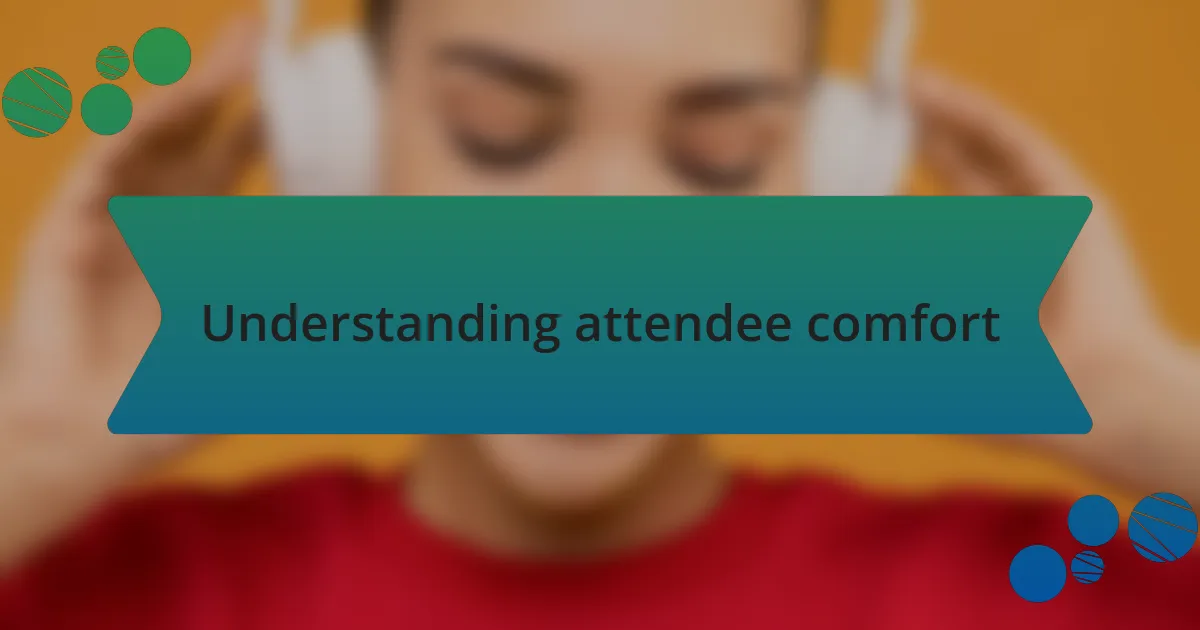
Understanding attendee comfort
Understanding attendee comfort goes beyond just physical space; it involves creating an atmosphere that resonates emotionally with the audience. I remember attending a festival where the layout was so intuitive and inviting that I felt a sense of ease wash over me from the moment I entered. The blend of sound and space had an almost magical quality that made moving between stages a pleasure rather than a chore.
Have you ever noticed how the smallest details can make a big difference? Simple elements like seating options and access to refreshments can significantly enhance comfort. At one event, the organizers provided cozy lounge areas, which not only offered respite but also fostered social connections among attendees. When I took a break there, I found myself engrossed in a conversation with a stranger, which turned into a memorable connection that lasted long after the event.
Moreover, understanding attendee comfort involves anticipating their needs. I often think back to a concert where the restrooms were easy to find and never had long lines. This attention to detail made me feel more at ease, allowing me to focus on what truly mattered—the music and the overall experience. Isn’t it fascinating how such thoughtful planning can transform an event from merely enjoyable to truly unforgettable?
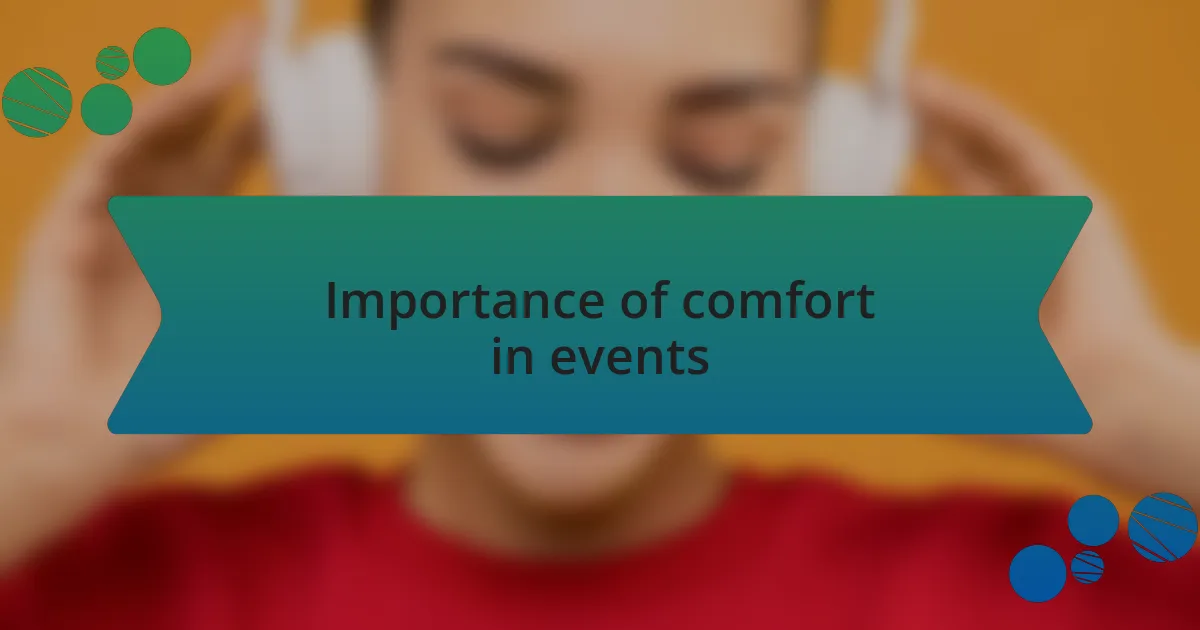
Importance of comfort in events
Creating a comfortable environment at events is crucial for attendees to engage fully with the experience. I recall a particularly well-organized rave where the temperature control was just right—cool enough to dance the night away without feeling stifled. It made me wonder, how often do we overlook such simple yet vital factors that can elevate our enjoyment?
Let’s not forget about accessibility, which often plays a critical role in attendee comfort. I once attended a large festival where the pathways were well marked, and staff were readily available to assist. This thoughtful approach not only reduced my stress but also allowed me to focus on exploring new sounds and connecting with fellow music lovers. Have you ever felt how much ease empowers enjoyment?
In essence, the comfort of event attendees is a reflection of how well the organizers understand their audience. During a recent electronic music festival, I was taken by how the placement of interactive art installations invited attendees to pause and take it all in. It struck me that comfort extends beyond physical amenities; it fosters a sense of community and belonging. How impactful is an atmosphere where everyone feels valued and included?

Key elements of event design
When it comes to event design, sound quality is a key element that cannot be overlooked. I remember attending a festival where the sound system was meticulously calibrated for every stage. The difference was palpable; the music resonated beautifully, enhancing my connection to the artists performing. Have you ever noticed how a well-balanced audio experience can transform not just the performance but the entire atmosphere?
Lighting also plays a pivotal role in creating immersive environments. During one event, I found myself captivated by soft, pulsating lights that synced with the music, guiding my emotions through the night. It made me realize that effective lighting does more than illuminate; it shapes the experience, influencing how we feel and interact with the space and each other. How often do we think about lighting beyond its practical purpose?
Another essential aspect of event design is seating and relaxation areas. I vividly recall a rave with chic lounge spaces scattered throughout, where attendees could take breaks and recharge. This thoughtful inclusion encouraged socializing and made me appreciate the design strategy behind it. Isn’t it fascinating how even the layout of a space can foster connections and allow us to savor the experience more fully?
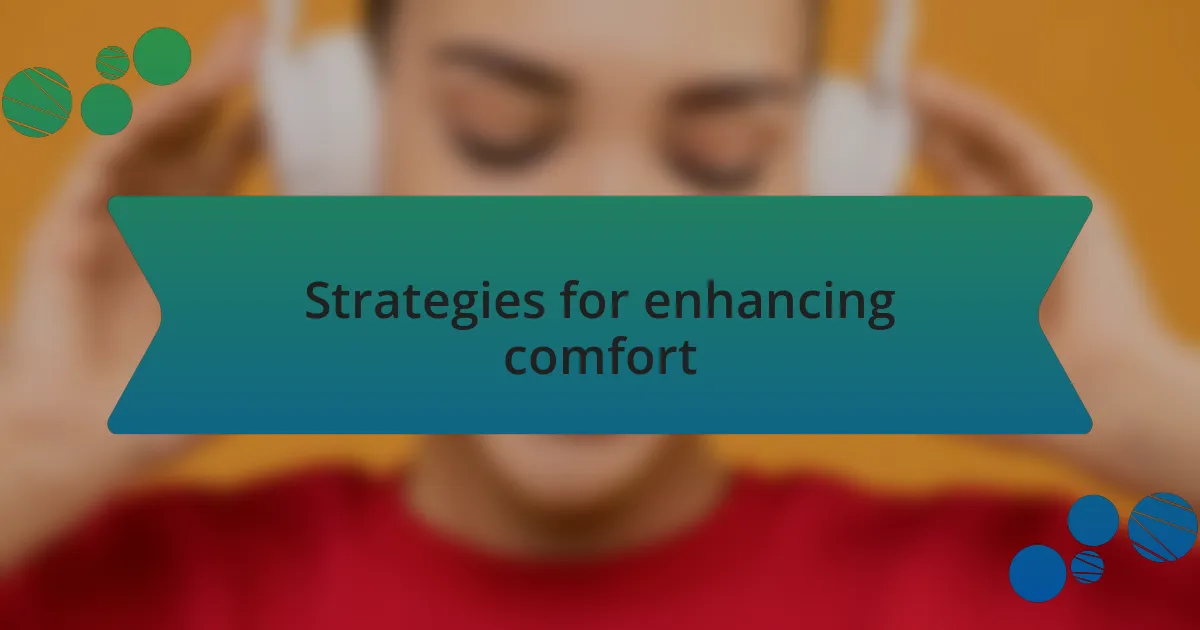
Strategies for enhancing comfort
One effective strategy for enhancing comfort at events is ensuring adequate hydration stations. I recall an outdoor festival where large water stations were strategically placed throughout the venue. Not only did this prevent long lines and promote easy access to water, but it also encouraged attendees to stay refreshed and energized. Have you ever noticed how a simple sip of water can transform your mood, especially when dancing for hours?
Another crucial aspect is temperature control, which often gets overlooked. I attended a gala where the organizers anticipated changes in weather by providing fans and shaded areas. The relief from the heat was a game changer, allowing everyone to enjoy the festivities without feeling drained. Isn’t it interesting how a comfortable temperature can impact your willingness to engage with others and immerse yourself in the event?
Incorporating thoughtful sensory elements also greatly contributes to attendee comfort. At one electronic music event, I was pleasantly surprised by the inclusion of soft, aromatic scents in the relaxation zones. The combination of music, scents, and comfortable seating created an atmosphere that invited me to linger longer. How often do we consider how our senses shape our overall experience?
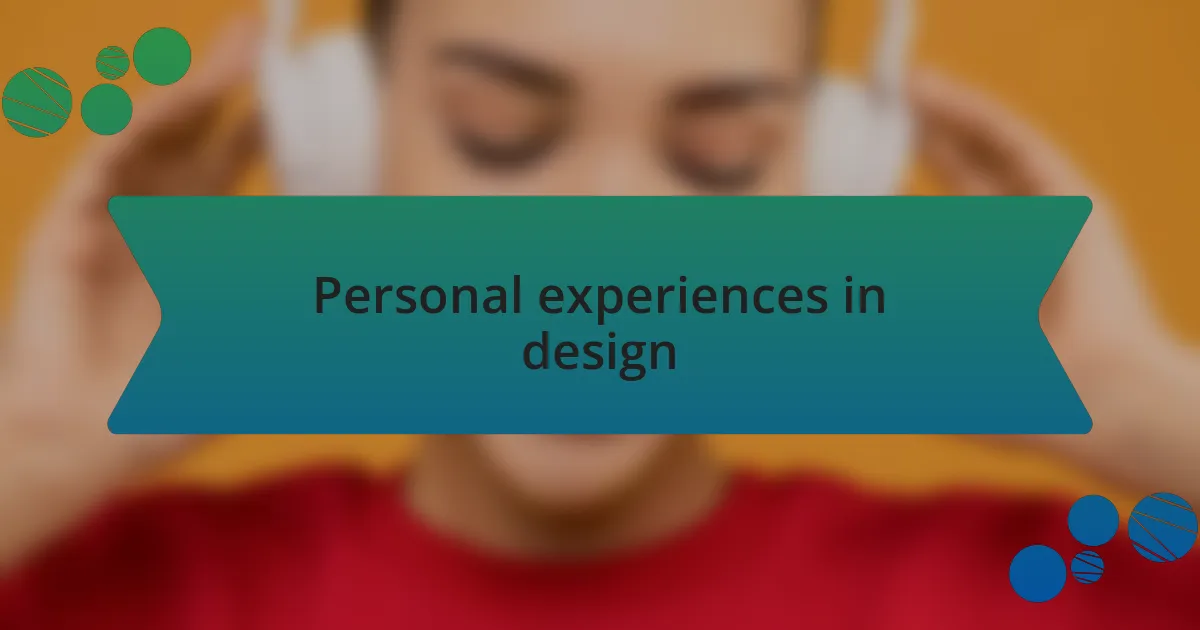
Personal experiences in design
Designing for attendee comfort is often a personal journey for me. I remember working on a small indoor rave, where the layout became critical. By using soft lounge areas with warm lighting, I noticed attendees clung to those spots, chatting and connecting in groups. It struck me how a simple design choice could encourage deeper interactions among strangers.
One night, I experimented with lighting elements that changed with the tempo of the music. Watching the crowd shift with the hues was magical. It wasn’t just about aesthetics; it transformed the energy in the room. Have you ever felt how vibrant colors can energize or calm you? That’s the kind of experience I aim to create—one that resonates emotionally with attendees.
I also take pride in understanding the emotional highs and lows of a music event. During a particularly long festival, I introduced quiet zones nestled away from the main stages. Observing tired festival-goers resting and rejuvenating reminded me that comfort is not just physical; it’s about feeling emotionally supported in our space. How often do we overlook the need for rejuvenation during exhilarating, yet exhausting experiences?
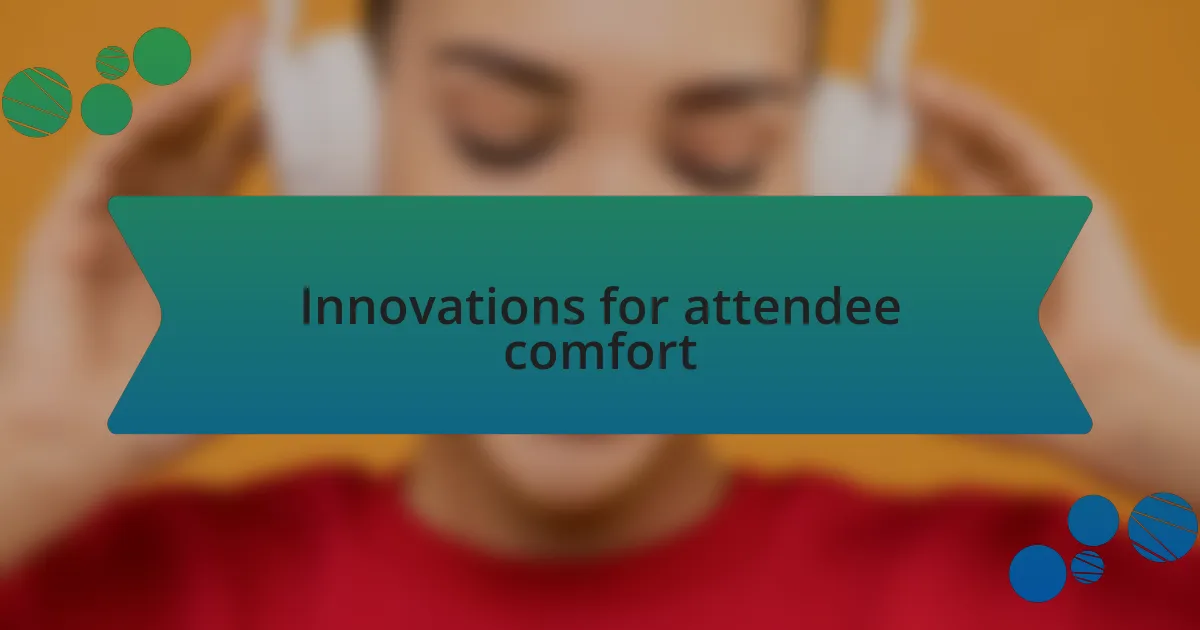
Innovations for attendee comfort
Innovations for attendee comfort can come from unexpected places. I remember integrating personalized cooling systems at an outdoor festival. Attendees were amazed at how the gentle mist created a refreshing oasis amidst the summer heat. It made me realize how essential climate control is in enhancing the overall experience. Have you ever experienced discomfort that pulled you away from the music?
Another intriguing idea I’ve implemented is the use of interactive seating arrangements. In one event, I arranged chairs in a semi-circle, encouraging face-to-face engagement rather than the typical rows that foster a disconnect. Observing how attendees naturally gravitated toward each other reinforced my belief that seating can dramatically influence social dynamics. Isn’t it fascinating how slight changes in layout can spark new connections?
I’ve also delved into sensory design. Recently, I experimented with scent-infused environments that reflected the theme of the night. The reactions were astonishing; attendees shared that the aromas took them back to cherished memories, creating a link between smell and sound. Have you ever had a memory triggered by a particular scent? This approach made me recognize the potent influence of multisensory experiences on comfort during events.

Gathering feedback for improvement
Gathering feedback is a critical step in enhancing attendee comfort. After a recent festival, I sent out surveys to capture attendees’ thoughts on the various comfort innovations we had implemented. The responses were eye-opening; some highlighted unexpected issues, like the need for more accessible quiet zones. How many times have we overlooked small details that could significantly impact the overall experience?
One evening, while chatting with festival-goers, I learned that our quiet zones weren’t quite quiet enough. This prompted immediate adjustments for future events. Listening to attendees in real-time can provide insights that no survey can uncover. Have you ever changed a plan based on a simple conversation? It’s moments like these that truly guide my design decisions.
Not every suggestion might resonate, but it’s the feedback that may surprise you that’s most valuable. I recall an attendee mentioning the importance of cushions on benches for enhanced relaxation. It made me realize that even small comforts can enhance the experience significantly. Wouldn’t it be great if we could create environments where everyone feels completely at ease? Embracing feedback allows us to adapt and continually improve, ensuring every event feels welcoming and enjoyable.